The Impact of Cultural Context on International HRM Practices
VerifiedAdded on 2022/11/24
|5
|916
|478
Homework Assignment
AI Summary
This assignment solution explores the cultural context of International Human Resource Management (IHRM). It begins by defining culture and cultural concepts, emphasizing the collective programming of a group's behaviors, values, and beliefs. The solution then examines Hofstede's model, a framework for understanding cultural dimensions such as Power Distance Index, Individualism vs. Collectivism, Uncertainty Avoidance Index, Femininity vs. Masculinity, and Short-Term vs. Long-Term Orientation, providing examples of how these dimensions impact an organization like Ryanair. The assignment also includes a reflection on cross-cultural management research, highlighting the importance of cultural knowledge and observation skills in international business. Finally, it touches upon the development of cultures and their role in organizational growth and brand image. The solution includes a list of relevant references to support the analysis.
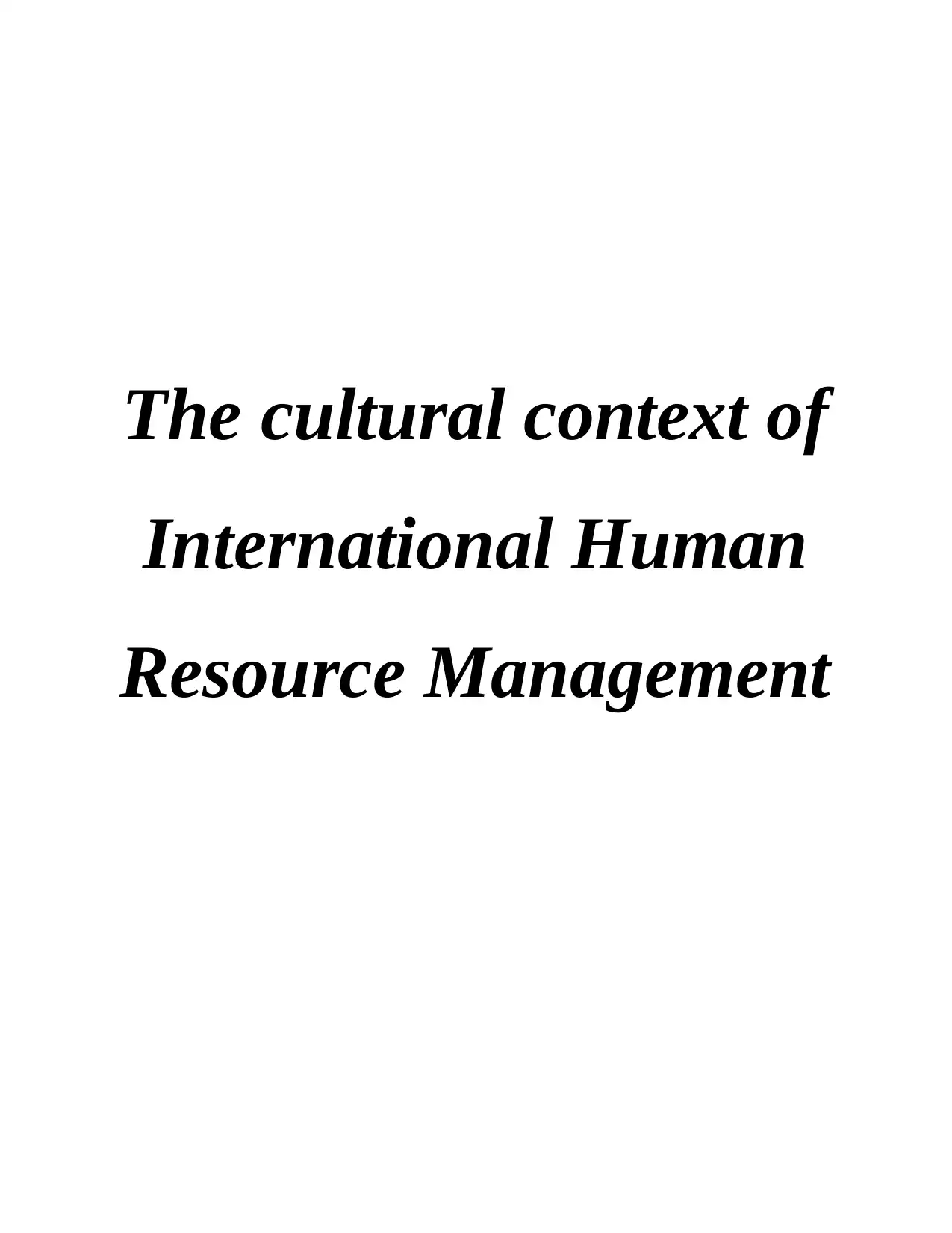
The cultural context of
International Human
Resource Management
International Human
Resource Management
Paraphrase This Document
Need a fresh take? Get an instant paraphrase of this document with our AI Paraphraser
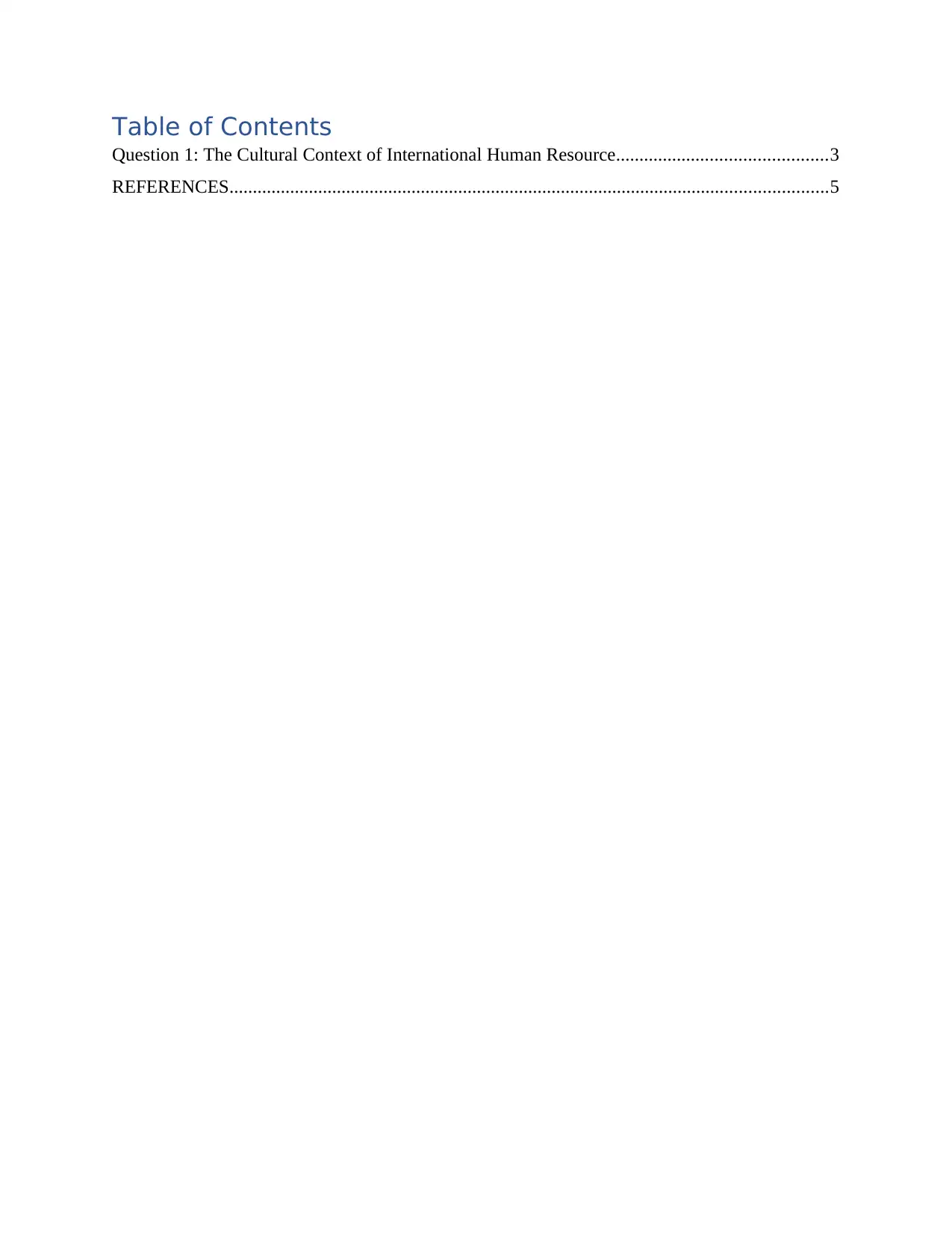
Table of Contents
Question 1: The Cultural Context of International Human Resource.............................................3
REFERENCES................................................................................................................................5
Question 1: The Cultural Context of International Human Resource.............................................3
REFERENCES................................................................................................................................5
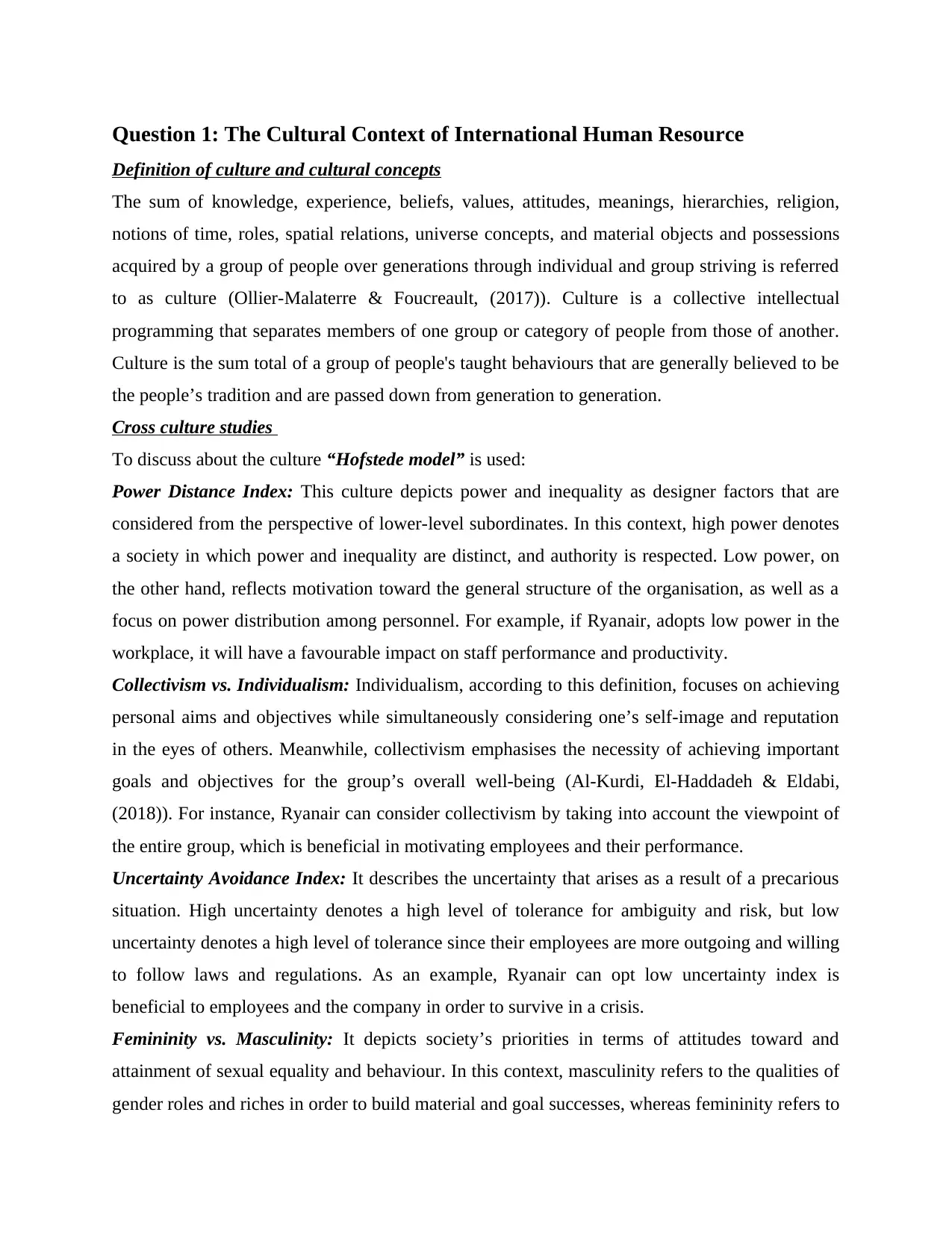
Question 1: The Cultural Context of International Human Resource
Definition of culture and cultural concepts
The sum of knowledge, experience, beliefs, values, attitudes, meanings, hierarchies, religion,
notions of time, roles, spatial relations, universe concepts, and material objects and possessions
acquired by a group of people over generations through individual and group striving is referred
to as culture (Ollier-Malaterre & Foucreault, (2017)). Culture is a collective intellectual
programming that separates members of one group or category of people from those of another.
Culture is the sum total of a group of people's taught behaviours that are generally believed to be
the people’s tradition and are passed down from generation to generation.
Cross culture studies
To discuss about the culture “Hofstede model” is used:
Power Distance Index: This culture depicts power and inequality as designer factors that are
considered from the perspective of lower-level subordinates. In this context, high power denotes
a society in which power and inequality are distinct, and authority is respected. Low power, on
the other hand, reflects motivation toward the general structure of the organisation, as well as a
focus on power distribution among personnel. For example, if Ryanair, adopts low power in the
workplace, it will have a favourable impact on staff performance and productivity.
Collectivism vs. Individualism: Individualism, according to this definition, focuses on achieving
personal aims and objectives while simultaneously considering one’s self-image and reputation
in the eyes of others. Meanwhile, collectivism emphasises the necessity of achieving important
goals and objectives for the group’s overall well-being (Al-Kurdi, El-Haddadeh & Eldabi,
(2018)). For instance, Ryanair can consider collectivism by taking into account the viewpoint of
the entire group, which is beneficial in motivating employees and their performance.
Uncertainty Avoidance Index: It describes the uncertainty that arises as a result of a precarious
situation. High uncertainty denotes a high level of tolerance for ambiguity and risk, but low
uncertainty denotes a high level of tolerance since their employees are more outgoing and willing
to follow laws and regulations. As an example, Ryanair can opt low uncertainty index is
beneficial to employees and the company in order to survive in a crisis.
Femininity vs. Masculinity: It depicts society’s priorities in terms of attitudes toward and
attainment of sexual equality and behaviour. In this context, masculinity refers to the qualities of
gender roles and riches in order to build material and goal successes, whereas femininity refers to
Definition of culture and cultural concepts
The sum of knowledge, experience, beliefs, values, attitudes, meanings, hierarchies, religion,
notions of time, roles, spatial relations, universe concepts, and material objects and possessions
acquired by a group of people over generations through individual and group striving is referred
to as culture (Ollier-Malaterre & Foucreault, (2017)). Culture is a collective intellectual
programming that separates members of one group or category of people from those of another.
Culture is the sum total of a group of people's taught behaviours that are generally believed to be
the people’s tradition and are passed down from generation to generation.
Cross culture studies
To discuss about the culture “Hofstede model” is used:
Power Distance Index: This culture depicts power and inequality as designer factors that are
considered from the perspective of lower-level subordinates. In this context, high power denotes
a society in which power and inequality are distinct, and authority is respected. Low power, on
the other hand, reflects motivation toward the general structure of the organisation, as well as a
focus on power distribution among personnel. For example, if Ryanair, adopts low power in the
workplace, it will have a favourable impact on staff performance and productivity.
Collectivism vs. Individualism: Individualism, according to this definition, focuses on achieving
personal aims and objectives while simultaneously considering one’s self-image and reputation
in the eyes of others. Meanwhile, collectivism emphasises the necessity of achieving important
goals and objectives for the group’s overall well-being (Al-Kurdi, El-Haddadeh & Eldabi,
(2018)). For instance, Ryanair can consider collectivism by taking into account the viewpoint of
the entire group, which is beneficial in motivating employees and their performance.
Uncertainty Avoidance Index: It describes the uncertainty that arises as a result of a precarious
situation. High uncertainty denotes a high level of tolerance for ambiguity and risk, but low
uncertainty denotes a high level of tolerance since their employees are more outgoing and willing
to follow laws and regulations. As an example, Ryanair can opt low uncertainty index is
beneficial to employees and the company in order to survive in a crisis.
Femininity vs. Masculinity: It depicts society’s priorities in terms of attitudes toward and
attainment of sexual equality and behaviour. In this context, masculinity refers to the qualities of
gender roles and riches in order to build material and goal successes, whereas femininity refers to
⊘ This is a preview!⊘
Do you want full access?
Subscribe today to unlock all pages.

Trusted by 1+ million students worldwide
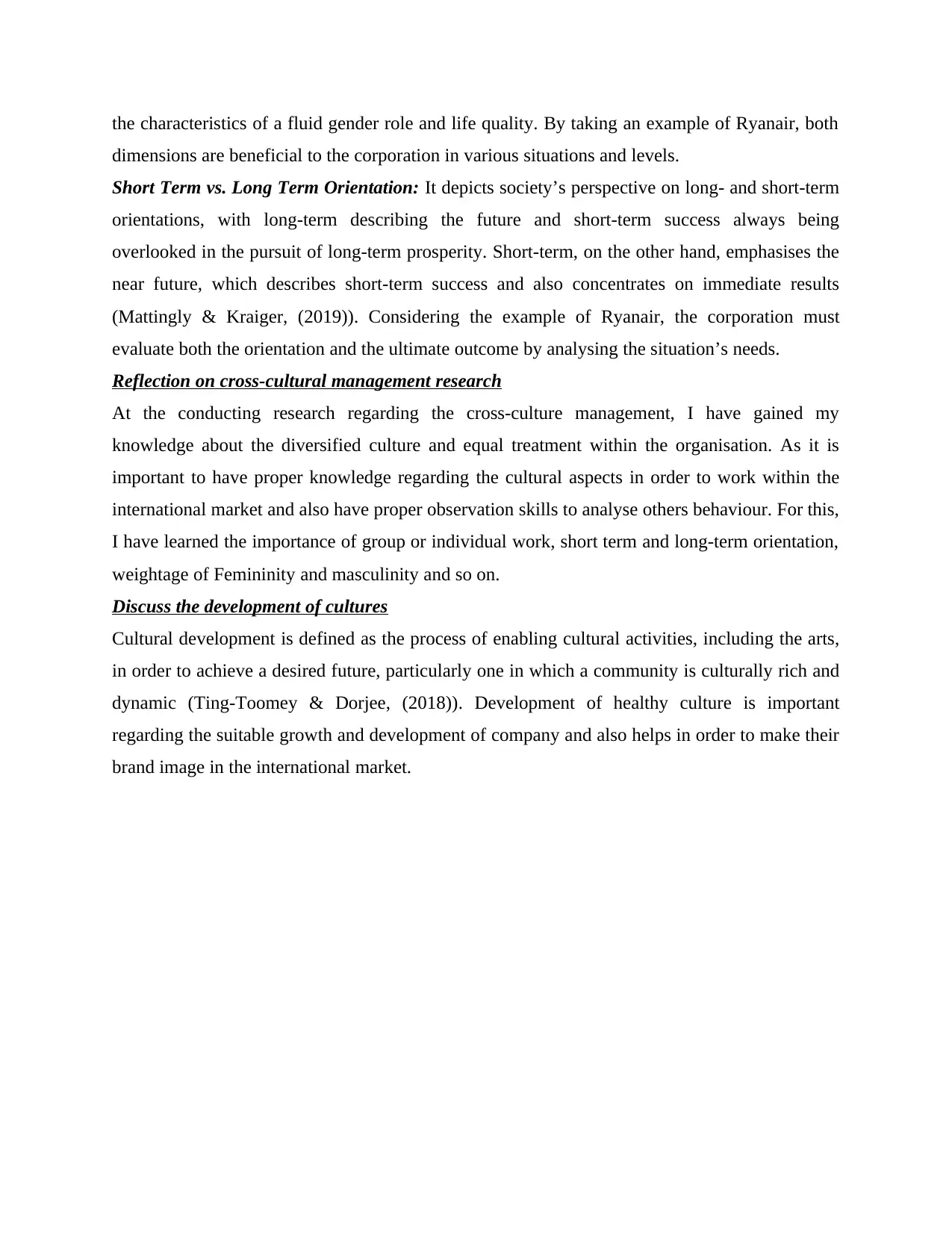
the characteristics of a fluid gender role and life quality. By taking an example of Ryanair, both
dimensions are beneficial to the corporation in various situations and levels.
Short Term vs. Long Term Orientation: It depicts society’s perspective on long- and short-term
orientations, with long-term describing the future and short-term success always being
overlooked in the pursuit of long-term prosperity. Short-term, on the other hand, emphasises the
near future, which describes short-term success and also concentrates on immediate results
(Mattingly & Kraiger, (2019)). Considering the example of Ryanair, the corporation must
evaluate both the orientation and the ultimate outcome by analysing the situation’s needs.
Reflection on cross-cultural management research
At the conducting research regarding the cross-culture management, I have gained my
knowledge about the diversified culture and equal treatment within the organisation. As it is
important to have proper knowledge regarding the cultural aspects in order to work within the
international market and also have proper observation skills to analyse others behaviour. For this,
I have learned the importance of group or individual work, short term and long-term orientation,
weightage of Femininity and masculinity and so on.
Discuss the development of cultures
Cultural development is defined as the process of enabling cultural activities, including the arts,
in order to achieve a desired future, particularly one in which a community is culturally rich and
dynamic (Ting-Toomey & Dorjee, (2018)). Development of healthy culture is important
regarding the suitable growth and development of company and also helps in order to make their
brand image in the international market.
dimensions are beneficial to the corporation in various situations and levels.
Short Term vs. Long Term Orientation: It depicts society’s perspective on long- and short-term
orientations, with long-term describing the future and short-term success always being
overlooked in the pursuit of long-term prosperity. Short-term, on the other hand, emphasises the
near future, which describes short-term success and also concentrates on immediate results
(Mattingly & Kraiger, (2019)). Considering the example of Ryanair, the corporation must
evaluate both the orientation and the ultimate outcome by analysing the situation’s needs.
Reflection on cross-cultural management research
At the conducting research regarding the cross-culture management, I have gained my
knowledge about the diversified culture and equal treatment within the organisation. As it is
important to have proper knowledge regarding the cultural aspects in order to work within the
international market and also have proper observation skills to analyse others behaviour. For this,
I have learned the importance of group or individual work, short term and long-term orientation,
weightage of Femininity and masculinity and so on.
Discuss the development of cultures
Cultural development is defined as the process of enabling cultural activities, including the arts,
in order to achieve a desired future, particularly one in which a community is culturally rich and
dynamic (Ting-Toomey & Dorjee, (2018)). Development of healthy culture is important
regarding the suitable growth and development of company and also helps in order to make their
brand image in the international market.
Paraphrase This Document
Need a fresh take? Get an instant paraphrase of this document with our AI Paraphraser
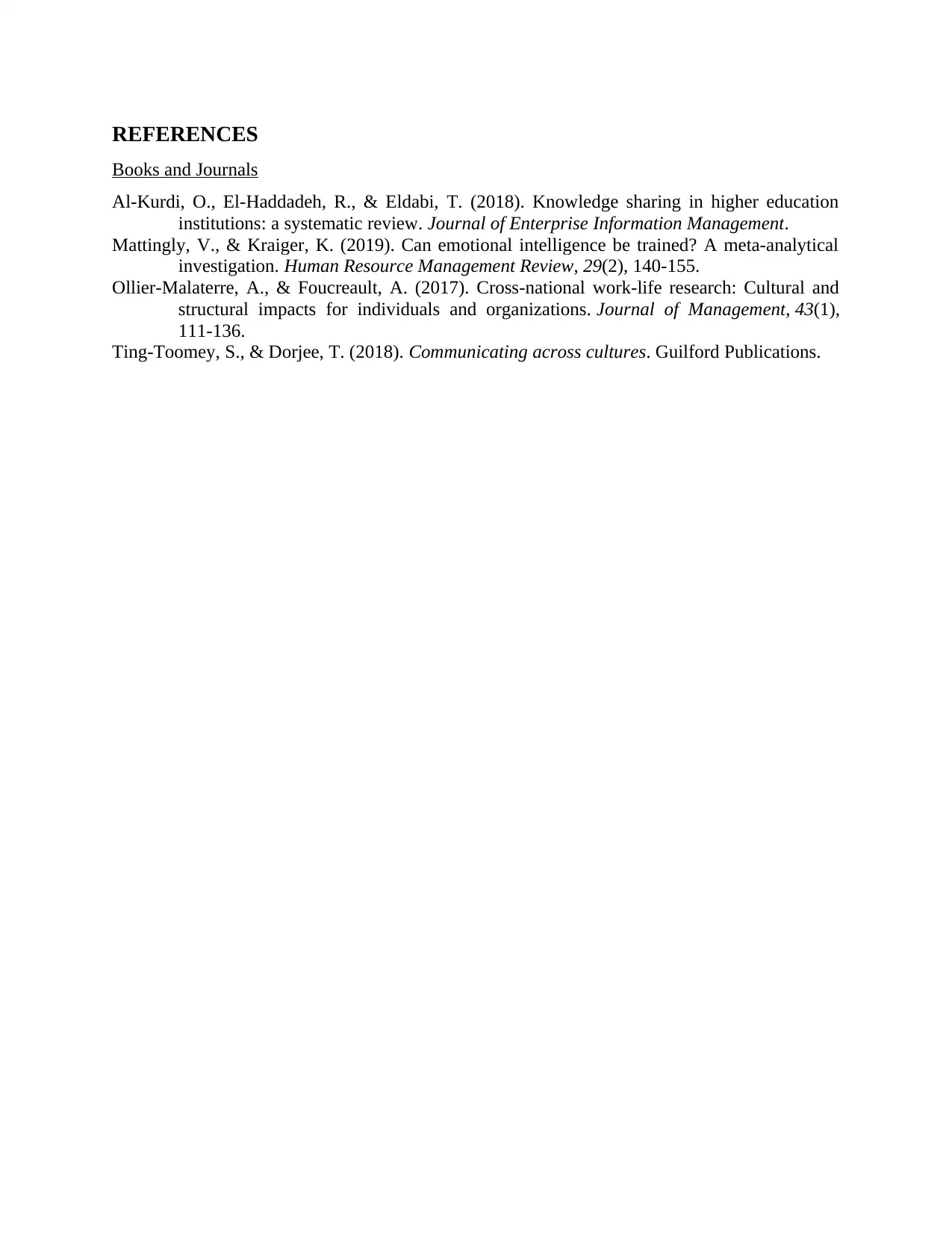
REFERENCES
Books and Journals
Al-Kurdi, O., El-Haddadeh, R., & Eldabi, T. (2018). Knowledge sharing in higher education
institutions: a systematic review. Journal of Enterprise Information Management.
Mattingly, V., & Kraiger, K. (2019). Can emotional intelligence be trained? A meta-analytical
investigation. Human Resource Management Review, 29(2), 140-155.
Ollier-Malaterre, A., & Foucreault, A. (2017). Cross-national work-life research: Cultural and
structural impacts for individuals and organizations. Journal of Management, 43(1),
111-136.
Ting-Toomey, S., & Dorjee, T. (2018). Communicating across cultures. Guilford Publications.
Books and Journals
Al-Kurdi, O., El-Haddadeh, R., & Eldabi, T. (2018). Knowledge sharing in higher education
institutions: a systematic review. Journal of Enterprise Information Management.
Mattingly, V., & Kraiger, K. (2019). Can emotional intelligence be trained? A meta-analytical
investigation. Human Resource Management Review, 29(2), 140-155.
Ollier-Malaterre, A., & Foucreault, A. (2017). Cross-national work-life research: Cultural and
structural impacts for individuals and organizations. Journal of Management, 43(1),
111-136.
Ting-Toomey, S., & Dorjee, T. (2018). Communicating across cultures. Guilford Publications.
1 out of 5
Related Documents
Your All-in-One AI-Powered Toolkit for Academic Success.
+13062052269
info@desklib.com
Available 24*7 on WhatsApp / Email
![[object Object]](/_next/static/media/star-bottom.7253800d.svg)
Unlock your academic potential
Copyright © 2020–2025 A2Z Services. All Rights Reserved. Developed and managed by ZUCOL.





